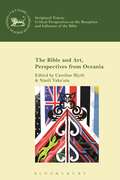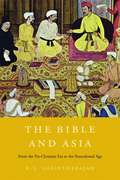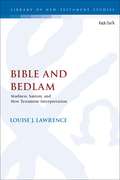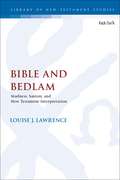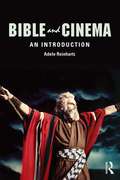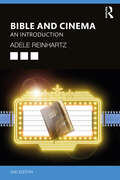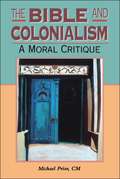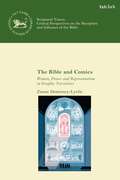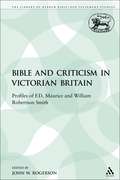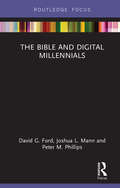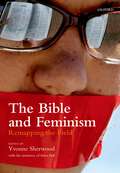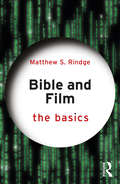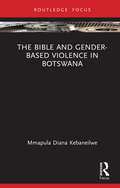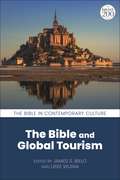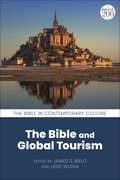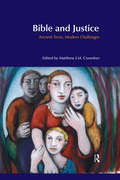- Table View
- List View
The Bible and Art, Perspectives from Oceania (The Library of Hebrew Bible/Old Testament Studies)
by Caroline Blyth Nasili Vaka’utaThis volume takes readers on a fascinating journey through the visual arts of Aotearoa New Zealand, Australia and the Pacific Islands, contemplating the multivocal dialogues that occur between these artistic media and the texts and traditions of the Bible. With their distinctively antipodean perspectives, contributors explore the innovative ways that both creators and beholders of Oceanic arts draw upon their contexts and cultures in order to open up creative engagements with the stories, themes and theologies of the biblical traditions. Various motifs weave their way throughout the volume, including antipodean landscapes and ecology, (post)colonialism, philosophy, Oceanic spiritualities and the often contested engagements between western and indigenous cultures. Within this weaving process, each essay invites readers to contemplate these various forms of visual culture through Oceanic eyes, and to appreciate the fresh insights that this process can bring to reading and interpreting the biblical traditions. The result is a rich and interdisciplinary array of conversations that will capture the attention of readers within the fields of biblical reception studies, cultural studies, theology and art history.
The Bible and Asia: From The Pre-christian Era To The Postcolonial Age
by R. S. SugirtharajahThe Bible's influence on the West has received much more attention than its complex career in the East. R. S. Sugirtharajah's expansive study of Asia's idiosyncratic relationship with the Bible tells of missionaries, imperialists, and reformers who molded Biblical texts in order to influence religion, politics, and daily life from India to China.
The Bible and Asia: From The Pre-christian Era To The Postcolonial Age
by R. S. SugirtharajahThe Bible's influence on the West has received much more attention than its complex career in the East. R. S. Sugirtharajah's expansive study of Asia's idiosyncratic relationship with the Bible tells of missionaries, imperialists, and reformers who molded Biblical texts in order to influence religion, politics, and daily life from India to China.
Bible and Bedlam: Madness, Sanism, and New Testament Interpretation (The Library of New Testament Studies)
by Louise J. LawrenceBible and Bedlam first critically questions the exclusion and stereotyping of certain biblical characters and scholars perceived as 'mad', as such judgements illustrate the 'sanism' (prejudice against individuals who are diagnosed or perceived as mentally ill) perpetuated within the discipline of Western biblical studies. Second, it seeks to highlight the widespread ideological 'gatekeeping' - 'protection' and 'policing' of madness in both western history and scholarship - with regard to celebrated biblical figures, including Jesus and Paul. Third, it initiates creative exchanges between biblical texts, interpretations and contemporary voices from 'mad' studies and sources (autobiographies, memoirs etc.), which are designed to critically disturb, disrupt and displace commonly projected (and often pejorative) assumptions surrounding 'madness'. Voices of those subject to diagnostic labelling such as autism, schizophrenia and/or psychosis are among those juxtaposed here with selected biblical interpretations and texts.
Bible and Bedlam: Madness, Sanism, and New Testament Interpretation (The Library of New Testament Studies #594)
by Louise J. LawrenceBible and Bedlam first critically questions the exclusion and stereotyping of certain biblical characters and scholars perceived as 'mad', as such judgements illustrate the 'sanism' (prejudice against individuals who are diagnosed or perceived as mentally ill) perpetuated within the discipline of Western biblical studies. Second, it seeks to highlight the widespread ideological 'gatekeeping' - 'protection' and 'policing' of madness in both western history and scholarship - with regard to celebrated biblical figures, including Jesus and Paul. Third, it initiates creative exchanges between biblical texts, interpretations and contemporary voices from 'mad' studies and sources (autobiographies, memoirs etc.), which are designed to critically disturb, disrupt and displace commonly projected (and often pejorative) assumptions surrounding 'madness'. Voices of those subject to diagnostic labelling such as autism, schizophrenia and/or psychosis are among those juxtaposed here with selected biblical interpretations and texts.
Bible and Cinema: An Introduction
by Adele ReinhartzThis is a comprehensive introduction to the ways in which the Bible has been used and represented in mainstream cinema. Adele Reinhartz considers the pervasive use of the Bible in feature films, and the medium of film as part of the Bible’s reception history. The book examines how films draw on the Old and New Testament and the figure of Jesus Christ in various direct and indirect ways to develop their plots, characters, and themes. As well as movies that set out explicitly to retell biblical stories in their ancient context, it explores the ways in which contemporary, fictional feature films make use of biblical narrative. Topics covered include: how filmmakers make use of scripture to address and reflect their own time and place. the Bible as a vehicle through which films can address social and political issues, reflect human experiences and emotions, explore existential issues such as evil and death, and express themes such as destruction and redemption. the role of the Bible as a source of ethics and morality, and how this connection is both perpetuated and undermined in a range of contemporary Hollywood films. films that create an experience of transcendence, and the ways in which the Bible figures in that experience. Reinhartz offers insightful analysis of numerous films including The Ten Commandments and The Shawshank Redemption, paying attention to visual and aural elements as well as plot, character, and dialogue. Students will find this an invaluable guide to a growing field.
Bible and Cinema: An Introduction
by Adele ReinhartzThis is a comprehensive introduction to the ways in which the Bible has been used and represented in mainstream cinema. Adele Reinhartz considers the pervasive use of the Bible in feature films, and the medium of film as part of the Bible’s reception history. The book examines how films draw on the Old and New Testament and the figure of Jesus Christ in various direct and indirect ways to develop their plots, characters, and themes. As well as movies that set out explicitly to retell biblical stories in their ancient context, it explores the ways in which contemporary, fictional feature films make use of biblical narrative. Topics covered include: how filmmakers make use of scripture to address and reflect their own time and place. the Bible as a vehicle through which films can address social and political issues, reflect human experiences and emotions, explore existential issues such as evil and death, and express themes such as destruction and redemption. the role of the Bible as a source of ethics and morality, and how this connection is both perpetuated and undermined in a range of contemporary Hollywood films. films that create an experience of transcendence, and the ways in which the Bible figures in that experience. Reinhartz offers insightful analysis of numerous films including The Ten Commandments and The Shawshank Redemption, paying attention to visual and aural elements as well as plot, character, and dialogue. Students will find this an invaluable guide to a growing field.
Bible and Cinema: An Introduction
by Adele ReinhartzBible and Cinema: An Introduction is a comprehensive examination of how the Bible has been used and represented in mainstream cinema to develop its plots, characters, and themes. The book considers two general types of films: Bible movies that retell biblical stories, such as the Exodus and the life of Jesus, and Bible-related movies that make use of biblical books, stories, verses, and figures, and Bibles themselves to tell non-biblical, often fictional, narratives. Topics covered include: the contribution of Bible and Bible-related movies to the history of the Bible’s reception; the ways in which filmmakers make use of scripture to address and reflect their own time and place; the Bible as a vehicle through which films can address social and political issues, reflect human experiences and emotions, explore existential issues such as evil and death, and express themes such as destruction and redemption; the role of the Bible as a source of ethics and morality, and how this role is both perpetuated and undermined in a range of contemporary Hollywood films; and film as a medium for experiences of transcendence, and the role of the Bible in creating such experiences. This thoroughly updated second edition includes insightful analysis of films such as Noah, Gods and Men, Mary Magdalene, and The Shawshank Redemption, paying attention to visual and aural elements as well as plot, character, and dialogue. The book also includes pedagogical resources including discussions of film theory, as well as key words and discussion questions. Teachers, students, and anyone interested in the intersection of Bible and cinema will find this an invaluable guide to a growing field.
Bible and Cinema: An Introduction
by Adele ReinhartzBible and Cinema: An Introduction is a comprehensive examination of how the Bible has been used and represented in mainstream cinema to develop its plots, characters, and themes. The book considers two general types of films: Bible movies that retell biblical stories, such as the Exodus and the life of Jesus, and Bible-related movies that make use of biblical books, stories, verses, and figures, and Bibles themselves to tell non-biblical, often fictional, narratives. Topics covered include: the contribution of Bible and Bible-related movies to the history of the Bible’s reception; the ways in which filmmakers make use of scripture to address and reflect their own time and place; the Bible as a vehicle through which films can address social and political issues, reflect human experiences and emotions, explore existential issues such as evil and death, and express themes such as destruction and redemption; the role of the Bible as a source of ethics and morality, and how this role is both perpetuated and undermined in a range of contemporary Hollywood films; and film as a medium for experiences of transcendence, and the role of the Bible in creating such experiences. This thoroughly updated second edition includes insightful analysis of films such as Noah, Gods and Men, Mary Magdalene, and The Shawshank Redemption, paying attention to visual and aural elements as well as plot, character, and dialogue. The book also includes pedagogical resources including discussions of film theory, as well as key words and discussion questions. Teachers, students, and anyone interested in the intersection of Bible and cinema will find this an invaluable guide to a growing field.
The Bible and Colonialism: A Moral Critique (Biblical Seminar)
by Michael PriorThe biblical claim of the divine promise of land is integrally linked with a divine mandate to exterminate the indigenous people. The narrative has supported virtually all Western colonizing enterprises (e.g. in Latin America, South Africa, Palestine), resulting in the suffering of millions of people, and loss of respect for the Bible. According to modern secular standards of human and political rights, what the biblical narrative calls for are war-crimes and crimes against humanity. In this provocative and compelling study, Prior protests at the neglect of the moral question in conventional biblical studies, and attempts to rescue the Bible from being a blunt instrument in the oppression of people.
The Bible and Comics: Women, Power and Representation in Graphic Narratives (The Library of Hebrew Bible/Old Testament Studies)
by Dr. Zanne Domoney-LyttleThis interdisciplinary volume seeks to trace the diverse ways in which stories of biblical women have been reimagined in and as comic books. Feminist biblical scholarship has previously addressed the tradition that relegates female biblical characters to secondary roles, merely enabling the male characters to attain their own goals. Using examples from both secular and religious comic Bibles, and comic Bibles aimed at children and older audiences, Zanne Domoney-Lyttle now fully considers contemporary remediations of biblical narratives to the same degree. Remediating ancient, biblical text into modern, graphical comic books affects the reception of the text in several ways. This book aims to investigate how the production, format, and function of comic Bibles encourages the depiction of biblical characters from a contemporary perspective, while also showing some fidelity to the text. By presenting a focused analysis on women in the Bible, wider issues concerning popular-cultural retellings of the Bible in general begin to surface, including matters concerning reception history, the space between art and literature inhabited by biblical comics, and issues of translation and interpretations within contemporary remediations.
The Bible and Comics: Women, Power and Representation in Graphic Narratives (The Library of Hebrew Bible/Old Testament Studies)
by Dr. Zanne Domoney-LyttleThis interdisciplinary volume seeks to trace the diverse ways in which stories of biblical women have been reimagined in and as comic books. Feminist biblical scholarship has previously addressed the tradition that relegates female biblical characters to secondary roles, merely enabling the male characters to attain their own goals. Using examples from both secular and religious comic Bibles, and comic Bibles aimed at children and older audiences, Zanne Domoney-Lyttle now fully considers contemporary remediations of biblical narratives to the same degree. Remediating ancient, biblical text into modern, graphical comic books affects the reception of the text in several ways. This book aims to investigate how the production, format, and function of comic Bibles encourages the depiction of biblical characters from a contemporary perspective, while also showing some fidelity to the text. By presenting a focused analysis on women in the Bible, wider issues concerning popular-cultural retellings of the Bible in general begin to surface, including matters concerning reception history, the space between art and literature inhabited by biblical comics, and issues of translation and interpretations within contemporary remediations.
The Bible and Criticism in Victorian Britain: Profiles of F.D. Maurice and William Robertson Smith (The Library of Hebrew Bible/Old Testament Studies)
by John W. RogersonThis book contains the F.D. Maurice lectures for 1992 and six Gifford lectures of 1994. The Maurice lectures present the first account of Maurice as an Old Testament interpreter. The lectures on Smith concentrate upon his theological interests as an interpreter of the Bible, as well as the first account based on unpublished material of Smith's activity as a preacher. There is also a close investigation of Smith's links with Germany, and the influence upon him of Richard Rothe is investigated in some detail for the first time. One of the aims of the book is to show how, in their different ways, Maurice and Smith tried to relate the Old Testament to the two different periods of Victorian Britain in which they lived. The book also is intended as a further contribution to our knowledge of the history of biblical criticism in Britain.
The Bible and Digital Millennials (Routledge Focus on Religion)
by David G. Ford Joshua L. Mann Peter M. PhillipsThe Bible and Digital Millennials explores the place of the Bible in the lives of 18 to 35 year-olds who have been born into the digital age. As the use of digital media becomes increasingly pervasive, it should follow that it will have a significant effect on people’s engagement with religion and the sacred texts associated with it. Drawing on contemporary in-depth surveys, this study unpacks digital millennials’ stance towards, use of and engagement with the Bible in both offline and online settings. The book features results from a nationally representative survey of 2,000 young British people specifically commissioned for this project. The data is also compared with the findings of others, including a poll of 850 British Bible-centric Christians and recent Bible engagement surveys from the USA. This book investigates the relevance of the Bible to the lives of those who have grown up in the digital age. It will, therefore, offer fresh insight to any scholar of biblical studies, religion and digital media, and religious studies.
The Bible and Digital Millennials (Routledge Focus on Religion)
by David G. Ford Joshua L. Mann Peter M. PhillipsThe Bible and Digital Millennials explores the place of the Bible in the lives of 18 to 35 year-olds who have been born into the digital age. As the use of digital media becomes increasingly pervasive, it should follow that it will have a significant effect on people’s engagement with religion and the sacred texts associated with it. Drawing on contemporary in-depth surveys, this study unpacks digital millennials’ stance towards, use of and engagement with the Bible in both offline and online settings. The book features results from a nationally representative survey of 2,000 young British people specifically commissioned for this project. The data is also compared with the findings of others, including a poll of 850 British Bible-centric Christians and recent Bible engagement surveys from the USA. This book investigates the relevance of the Bible to the lives of those who have grown up in the digital age. It will, therefore, offer fresh insight to any scholar of biblical studies, religion and digital media, and religious studies.
The Bible and Feminism: Remapping the Field
by Yvonne SherwoodThis groundbreaking book breaks with established canons and resists some of the stereotypes of feminist biblical studies. It features a wide range of contributors who showcase new methodological and theoretical movements such as feminist materialisms, intersectionality, postidentitarian 'nomadic' politics, gender archaeology, and lived religion, and theories of the human and the posthuman. The Bible and Feminism: Remapping the Field engages a range of social and political issues, including migration and xenophobia, divorce and family law, abortion, 'pinkwashing', the neoliberal university, the second amendment, AIDS and sexual trafficking, and the politics of 'the veil'. Foundational figures in feminist biblical studies work alongside new voices and contributors from a multitude of disciplines in conversations with the Bible that go well beyond the expected canon-within-the-canon assumed to be of interest to feminist biblical scholars. Moving beyond the limits of a text-orientated model of reading, this collection looks at how biblical texts were actualized in the lives of religious revolutionaries, such as Joanna Southcott or Sor Juana Inés de la Cruz. It charts the politics of the Pauline veil in the self-understanding of Europe and reads the 'genealogical halls' in the book of Chronicles alongside acts of commemoration and forgetting in 9/11 and Tiananmen Square.
The Bible and Feminism: Remapping the Field
This groundbreaking book breaks with established canons and resists some of the stereotypes of feminist biblical studies. It features a wide range of contributors who showcase new methodological and theoretical movements such as feminist materialisms, intersectionality, postidentitarian 'nomadic' politics, gender archaeology, and lived religion, and theories of the human and the posthuman. The Bible and Feminism: Remapping the Field engages a range of social and political issues, including migration and xenophobia, divorce and family law, abortion, 'pinkwashing', the neoliberal university, the second amendment, AIDS and sexual trafficking, and the politics of 'the veil'. Foundational figures in feminist biblical studies work alongside new voices and contributors from a multitude of disciplines in conversations with the Bible that go well beyond the expected canon-within-the-canon assumed to be of interest to feminist biblical scholars. Moving beyond the limits of a text-orientated model of reading, this collection looks at how biblical texts were actualized in the lives of religious revolutionaries, such as Joanna Southcott or Sor Juana Inés de la Cruz. It charts the politics of the Pauline veil in the self-understanding of Europe and reads the 'genealogical halls' in the book of Chronicles alongside acts of commemoration and forgetting in 9/11 and Tiananmen Square.
Bible and Film: The Basics (The Basics)
by Matthew S. RindgeBible and Film: The Basics is a concise, accessible, and illuminating introduction to the study of Bible and Film. The book introduces non-specialists to the essential content in Bible and Film, and to some of the most common and important methods Bible and Film scholars use. Questions asked throughout the book include: How do films (re)interpret and illuminate biblical texts? How do films appropriate, reconfigure, and transform biblical texts? How does a film's treatment of biblical texts help interpret and illuminate the film? This book examines various types of interplay between film and the Bible. The theme of ‘Bible on film’ is explored through Hebrew Bible epics including The Prince of Egypt and Noah, and Jesus films such as The Last Temptation of Christ and Son of Man. The theme ‘Bible in film’ is analyzed through films including Mary Magdalene, Magnolia, Pulp Fiction, and The Book of Eli. Films that ‘reimagine the Bible’ include Ex Machina, mother!, and The Tree of Life; unusual Jesus figures in Pan’s Labyrinth, Dogville, and Donnie Darko are also explored. ‘Film as Bible’ considers films such as To the Wonder, Silence, and Parasite. A conclusion examines television shows such as Dekalog, The West Wing, The Handmaid’s Tale, and God on Trial. With a glossary of key terms and suggestions for further reading throughout, this book is an ideal starting point for anyone seeking a full introduction to religion and film, bible and film, bible and popular culture, and theology and film.
Bible and Film: The Basics (The Basics)
by Matthew S. RindgeBible and Film: The Basics is a concise, accessible, and illuminating introduction to the study of Bible and Film. The book introduces non-specialists to the essential content in Bible and Film, and to some of the most common and important methods Bible and Film scholars use. Questions asked throughout the book include: How do films (re)interpret and illuminate biblical texts? How do films appropriate, reconfigure, and transform biblical texts? How does a film's treatment of biblical texts help interpret and illuminate the film? This book examines various types of interplay between film and the Bible. The theme of ‘Bible on film’ is explored through Hebrew Bible epics including The Prince of Egypt and Noah, and Jesus films such as The Last Temptation of Christ and Son of Man. The theme ‘Bible in film’ is analyzed through films including Mary Magdalene, Magnolia, Pulp Fiction, and The Book of Eli. Films that ‘reimagine the Bible’ include Ex Machina, mother!, and The Tree of Life; unusual Jesus figures in Pan’s Labyrinth, Dogville, and Donnie Darko are also explored. ‘Film as Bible’ considers films such as To the Wonder, Silence, and Parasite. A conclusion examines television shows such as Dekalog, The West Wing, The Handmaid’s Tale, and God on Trial. With a glossary of key terms and suggestions for further reading throughout, this book is an ideal starting point for anyone seeking a full introduction to religion and film, bible and film, bible and popular culture, and theology and film.
The Bible and Gender-based Violence in Botswana (ISSN)
by Mmapula Diana KebaneilweThe Bible and Gender-based Violence in Botswana foregrounds the rampancy of gender-based violence against women and girls in biblical texts and how it resonates with gender-based violence (GBV) in the author’s contemporary context of Botswana.The volume reads selected texts from the Bible alongside newspaper reports of GBV against women and girls in Botswana to show that while the Bible is taken as an authoritative text within the Botswana context, it is riddled with GBV against female persons. It asserts that by acknowledging and naming GBV in biblical texts and not concealing, ignoring, or spiritualizing it, contemporary communities of faith will be able to confront the problem in these contexts. By so doing, the book argues, the Bible will become a resource for positive transformation rather than a tool for supporting gender injustice.The book appeals to everyone willing to see positive change in regard to gender in/equality and is intended for a wide readership including researchers, postgraduates, church and other representatives of religious institutions, and upper-level undergraduates.
The Bible and Gender-based Violence in Botswana (ISSN)
by Mmapula Diana KebaneilweThe Bible and Gender-based Violence in Botswana foregrounds the rampancy of gender-based violence against women and girls in biblical texts and how it resonates with gender-based violence (GBV) in the author’s contemporary context of Botswana.The volume reads selected texts from the Bible alongside newspaper reports of GBV against women and girls in Botswana to show that while the Bible is taken as an authoritative text within the Botswana context, it is riddled with GBV against female persons. It asserts that by acknowledging and naming GBV in biblical texts and not concealing, ignoring, or spiritualizing it, contemporary communities of faith will be able to confront the problem in these contexts. By so doing, the book argues, the Bible will become a resource for positive transformation rather than a tool for supporting gender injustice.The book appeals to everyone willing to see positive change in regard to gender in/equality and is intended for a wide readership including researchers, postgraduates, church and other representatives of religious institutions, and upper-level undergraduates.
The Bible and Global Tourism (The Bible in Contemporary Culture)
by James S. Bielo & Lieke WijniaThis volume examines the ways in which biblical tourism is enmeshed within the production and management of heritage, global contexts of marketing and publicity, accessibility of sacred sites and routes for multiple audiences, and the forging of connections between travel and social identity. By exploring issues such as devotional piety, religious pedagogy, and entertainment, an interdisciplinary collection of scholars traces how biblical tourism experiences are choreographed and consumed, and how these practices shape embodied and narrative performances of scripture. Contributors focus on four major questions: How have people used tourism to develop new, or renewed, relationships with the Bible? Historically, what role has the Bible played in the development of modern tourism? In the context of the tourist encounter, how have people mobilized the Bible as a social and expressive resource? And what forms of social exchange shape acts of biblical tourism, such as among pilgrims, or between people and landscapes? These questions are centered not only around authorized shrines and “Holy Places,” but also festivals, museums, theme parks, and heritage sites. This book aims to create a comparative and interdisciplinary dialogue around the dynamic relationship between biblical heritage claims and the practices and infrastructures of modern tourism.
The Bible and Global Tourism (The Bible in Contemporary Culture)
This volume examines the ways in which biblical tourism is enmeshed within the production and management of heritage, global contexts of marketing and publicity, accessibility of sacred sites and routes for multiple audiences, and the forging of connections between travel and social identity. By exploring issues such as devotional piety, religious pedagogy, and entertainment, an interdisciplinary collection of scholars traces how biblical tourism experiences are choreographed and consumed, and how these practices shape embodied and narrative performances of scripture. Contributors focus on four major questions: How have people used tourism to develop new, or renewed, relationships with the Bible? Historically, what role has the Bible played in the development of modern tourism? In the context of the tourist encounter, how have people mobilized the Bible as a social and expressive resource? And what forms of social exchange shape acts of biblical tourism, such as among pilgrims, or between people and landscapes? These questions are centered not only around authorized shrines and “Holy Places,” but also festivals, museums, theme parks, and heritage sites. This book aims to create a comparative and interdisciplinary dialogue around the dynamic relationship between biblical heritage claims and the practices and infrastructures of modern tourism.
Bible and Justice: Ancient Texts, Modern Challenges (BibleWorld)
by Matthew J. CoomberThe Bible contains a variety of passages that defend the poor and champion the cause of the oppressed, but are these ancient texts able to find a voice in confronting injustice in the modern world? 'Bible and Justice' examines the ways in which the Bible can speak to contemporary poverty, environmental issues, and state-sponsored violence, whilst exploring the difficulties that arise when ancient concepts of justice are applied to modern ideals. The book covers a range of topics from human rights to deaf biblical interpretation and from hospitality to corporate globalization. Broad and accessible, 'Bible and Justice' will be an invaluable resource for students of religious and biblical studies.
Bible and Justice: Ancient Texts, Modern Challenges (BibleWorld)
by Matthew J. CoomberThe Bible contains a variety of passages that defend the poor and champion the cause of the oppressed, but are these ancient texts able to find a voice in confronting injustice in the modern world? 'Bible and Justice' examines the ways in which the Bible can speak to contemporary poverty, environmental issues, and state-sponsored violence, whilst exploring the difficulties that arise when ancient concepts of justice are applied to modern ideals. The book covers a range of topics from human rights to deaf biblical interpretation and from hospitality to corporate globalization. Broad and accessible, 'Bible and Justice' will be an invaluable resource for students of religious and biblical studies.
